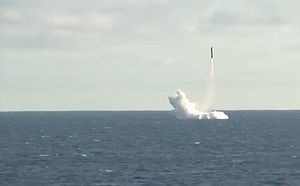A nuclear-powered ballistic missile submarine (SSBN) of the Russian Pacific Fleet had to abort the test firing of a submarine-launched ballistic missile (SLBM) during the annual Russian nuclear forces readiness exercise, dubbed “Grom” (Thunder) 2019, which took place from October 15 to 17, according to local media reports.
The Ryazan, a Project 667BDR Kal’mar (Squid) Delta-III SSBN commissioned in 1982, reportedly fired one instead of the planned two R-29RMU Sineva (NATO reporting name: SS-N-23A Skiff) SLBMs from a submerged position in the Sea of Okhotsk into the Chizha test range on the Kanin Peninsula. “The second R-29R did not exit the silo launcher, and the submarine returned to its home base with an unexploded missile,” the Vedomosti newspaper wrote on October 21 based on information provided by two unnamed sources familiar with the missile tests.
Defense analysts speculated that the Soviet-era boomer misfired the SLBM, a weapon system first introduced into service in the late 1977s, as a result of a technical malfunction. The Russian Ministry of Defense (MoD) has rejected this as a mischaracterization of what occurred. “After assessing the information about the technical condition of a missile on the submarine Ryazan received immediately before the launch, a decision was made against using it in a test-launch,” the MoD said in an October 21 statement. “In no way did the cancelled launch of this missile affect the successful results of the Thunder strategic command and staff drills.”
The principal aim of the exercise was to check Russian nuclear force’s command and control capabilities and “rather than the capability of launching the maximum number of missiles,” the MoD said.
“A final decision on the maximum number of intercontinental ballistic missile launches is made from the Russian Armed Forces’ command and control center, judging by the specifics of a notional operational situation and special combat training missions to inflict damage on a simulated enemy,” the ministry added.
There have also been Russian media reports that a Buyan-class corvette had difficulties launching a 3M-54 Kalibr stand-off supersonic anti-ship cruise missile during the exercise. The MoD, however, insisted that the test firing went according to plan.
Thunder 2019 took place from October 15 to 17 in all five military districts across Russia including the Western, Southern, Central and Eastern districts. It involved 12,000 troops, 213 intercontinental-range ballistic missile launchers, up to 105 aircraft and around 20 warships including five submarines.
As part of the exercise a Project 667 BDRM Delta IV SSBN of the Russian Navy’s Norther Fleet successfully launched RSM-50 (NATO reporting name: SS-N-18 Stingray) SLBMs, according to the MoD. Notably, the exercise did not include the participation of the Russian Navy’s newest SSBN class armed, the Project 955 Borei-class (“North Wind”) aka Dolgoruky-class armed with the Bulava RSM-56 (NATO reporting name: SS-N-30) SLBM.

































